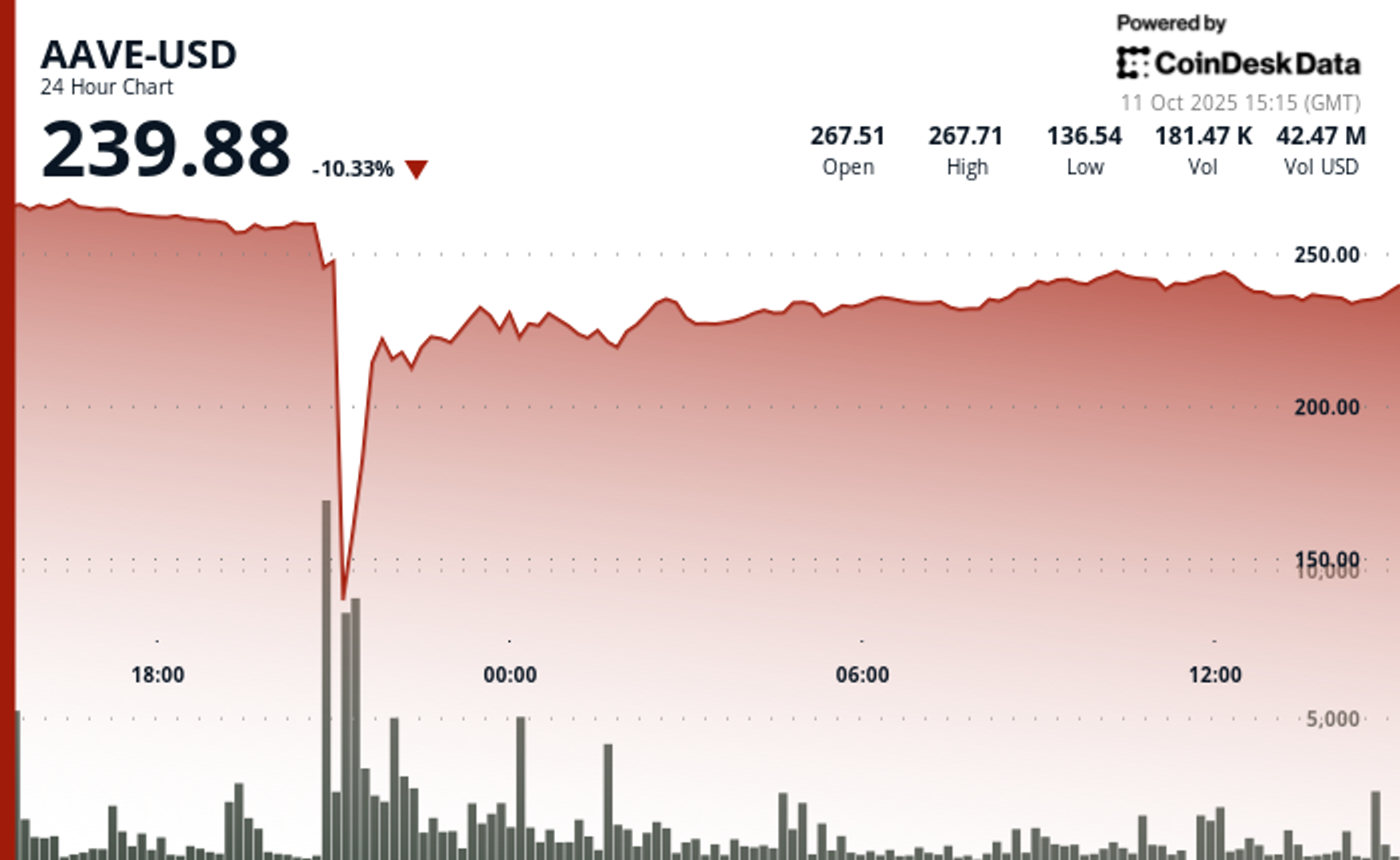Uncategorized
It’s Hard to Fund Midsize Green Assets. This Tokenization Startup Wants to Change That

The U.S. renewable energy industry is in an odd position.
Large-scale projects, like SunZia, the southwestern wind turbine project that is expected to provide enough electricity to power three million homes, are funded with relative ease thanks to long-established relationships with financial giants. Meanwhile, small-scale installations such as solar panels on one’s rooftop are becoming cheaper to implement by the day.
But the consolidation of the energy sector is making it increasingly difficult for mid-sized projects to get the financing they need. These ventures, which are typically worth less than $100 million, are too pricey for regular people to pay for, yet too modest for financial heavyweights to take an interest in them.
That’s where Plural Energy steps in. The two-year-old tokenization firm enables mid-sized renewable energy projects to raise funds from investors on-chain, with the double-aim of dramatically expanding the number of people who can invest in renewable energy assets while also developing new kinds of financial products for the energy sector.
“Right now, the process of raising capital for solar is just unacceptable. We’re never going to hit our climate goals,” Adam Silver, co-founder and CEO of Plural Energy, told CoinDesk in an interview. “[We want] to make an easy button for capital raising for good climate assets.”
“By taking advantage of tokenization, we can essentially unlock all of the magic that happens in DeFi ecosystems, and bring it to an industry that’s desperately in need of financial innovation,” Silver added.
Pitching to Plural Energy
Investors can access four types of products through Plural Energy. The first is small-scale asset-backed instruments, like a project bundling 1,000 rooftop solar installations into a single security, which is then tokenized. The second category is development-stage renewables, and the third is operating renewables (for example pre-existing solar plants that seek to raise additional funds to expand).
The fourth category, Silver said, is the “weird stuff,” like a battery that uses artificial intelligence (AI) to trade, or the bitcoin (BTC) mine being built by Sangha Renewables on a West Texas solar plant operated by an energy company. “Things that are a little bit out of the ordinary for traditional infrastructure investors, but are really cool to everyone else,” Silver said.
So far, the majority of these projects have involved solar power in one form or another, but Plural has also looked into wind-based initiatives and even a hydropower deal.
Yet these projects didn’t make it past Plural’s due diligence. To date, a total of five deals, representing $40 million, have been given the green light to raise funds through the platform. Only 5% of the deals considered by Plural make it to the finish line, but that hasn’t discouraged demand for the platform, which currently has around $150 million, across a dozen assets, to bring on board in the coming months.
“When a renewable energy company comes to us, we put it through our broker-dealer due diligence process, and then we also do asset due diligence,” Silver said. “We make sure that it’s like an asset that really any one of us would feel comfortable investing in personally.”
While broker-dealers must ensure that investors aren’t getting scammed, they aren’t necessarily responsible for making sure that something is a good investment. Nevertheless, the Plural team insists on only presenting deals that it’s confident in, Silver said.
The first ever project greenlit by Plural took six months to complete the process from start to finish, from agreeing to tokenize with Plural to a live tokenized security offering. That timeline has now been brought down to six weeks.
Plural’s business model and technologies “open up capital markets to the most sensible pool of investors, streamline the fundraising process, and provide transparency to all parties,” Spencer Marr, president of Sangha Renewables, told CoinDesk.
Investing through Plural Energy
Once they’ve been given the nod, issuers on Plural get to choose what types of securities they want to offer — like common equity, convertible notes with interest, or unsecured convertible notes. Each of these security instruments receives a unique token in the back-end. Investors then get to choose what kind of security they want, and receive the appropriate tokens for it.
But each deal comes with its own unique requirements. For example, one project gave retail investors the opportunity to invest as little as $500 in a portfolio of solar projects. In the case of Sangha’s bitcoin mine, however, the deal is only open for accredited investors, with a minimum investment of $50,000.
Plural is a registered transfer agent, meaning that it maintains the ownership documents, known as cap tables, of the projects financed through its platform. Under Plural’s system, each tokenized security gets its own on-chain cap table, the data from which is then cross-referenced with a Know-Your-Customer (KYC) database to generate an SEC-compliant cap table.
“The only way you can change who owns what [in the project] is by changing who owns what token. So the original source of action and movement is on-chain, and then it’s recorded in that off-chain database,” Silver said.
The code behind Plural’s transfer agent protocol is already open-source, he added, and the firm plans on publishing its transfer agent standard operating procedures as well. “We should not have a regulatory moat by having a transfer agent license,” Silver said. “That should not stand in the way between people accessing tokenization.”
Initially built on Base but now expanding to other EVM-compatible networks like Avalanche and Arbitrum, Plural offers a variety of payment options, including MetaMask, credit cards, ACH payments and wire transfers. While the company is mostly focused on U.S. investors, Silver said that Plural was mindful of international investors wanting exposure to the platform’s assets.
“Our first deal had Canadians and Europeans, but just because we had them doesn’t mean it’s good enough,” Silver said. “We have an opportunity to make a much cleaner and better investing experience for international investors that can perhaps simplify their regulatory burden in the U.S. and then also their tax burden.”
Green energy tokens in DeFi
Blockchain technology doesn’t just allow Plural to access a broader array of investors; it also enables innovations in terms of the platform’s payment systems.
One area the eight-person team is focusing on is using smart contracts to simplify payment terms, or how a given project splits its proceeds. For example, waterfall distribution schedules can see the project forward 98% of dividends to investors up to a threshold, and then evenly split the rest between investor and issuer.
“With smart contracts, the headache of administering and calculating all of that just completely goes away,” Silver said. “Now our issuers make a single payment into Plural and then smart contracts automate all the distributions according to business rules.”
Even better, Plural’s smart contracts track the trading of these tokenized securities, meaning that if an investor holds the token for the first 10 days of a month, then sells it to someone else for the remaining 20 days, the first investor will receive a third of the dividend, while the second will receive two-thirds. “We’re able to get closer to that real-time finance and just remove all that administration,” Silver said.
That opens up the possibility of Plural-issued tokens being used in the broader crypto economy, especially in decentralized finance (DeFi). Investors could eventually post their tokenized securities as collateral the same way on-chain market participants already use ether (ETH), stablecoins and various other cryptocurrencies. “It’s just a more usable product if you can borrow against it,” Silver said.
Assets tokenized by Plural could also end up being traded on decentralized exchanges, which would help bring them liquidity. “I don’t think it’s going to be easy, but I do think that figuring out how to take those liquidity principles and bring them into Plural is huge, and might be coming, hopefully sometime soon.”
Down the line, Plural’s assets could even end up spawning their own derivatives, and even split the generated interest from the tokenized security the same way DeFi protocol Pendle does.
“Either my kids, or my grandkids, or hopefully me — I really think we will get to a point where it’s faster to move between cash and clean energy assets than it is to move between checkings and savings accounts,” Silver said.
Business
AAVE Sees 64% Flash Crash as DeFi Protocol Endures ‘Largest Stress Test’

The native token of Aave (AAVE), the largest decentralized crypto lending protocol, was caught in the middle of Friday’s crypto flash crash while the protocol proved resilient in a historic liquidation cascade.
The token, trading at around $270 earlier in Friday, nosedived as much as 64% later in the session to touch $100, the lowest level in 14 months. It then staged a rapid rebound to near $240, still down 10% over the past 24 hours.
Stani Kulechov, founder of Aave, described Friday’s event as the «largest stress test» ever for the protocol and its $75 billion lending infrastructure.
The platform enables investors to lend and borrow digital assets without conventional intermediaries, using innovative mechanisms such as flash loans. Despite the extreme volatility, Aave’s performance underscores the evolving maturity and resilience of DeFi markets.
«The protocol operated flawlessly, automatically liquidating a record $180M worth of collateral in just one hour, without any human intervention,» Kulechov said in a Friday X post. «Once again, Aave has proven its resilience.»
Key price action:
- AAVE sustained a dramatic flash crash on Friday, declining 64% from $278.27 to $100.18 before recuperating to $240.09.
- The DeFi protocol demonstrated remarkable resilience with its native token’s 140% recovery from the intraday lows, underpinned by substantial trading volume of 570,838 units.
- Following the volatility, AAVE entered consolidation territory within a narrow $237.71-$242.80 range as markets digested the dramatic price action.
Technical Indicators Summary
- Price range of $179.12 representing 64% volatility during the 24-hour period.
- Volume surged to 570,838 units, substantially exceeding the 175,000 average.
- Near-term resistance identified at $242.80 capping rebound during consolidation phase.
Disclaimer: Parts of this article were generated with the assistance from AI tools and reviewed by our editorial team to ensure accuracy and adherence to our standards. For more information, see CoinDesk’s full AI Policy.
Business
Blockchain Will Drive the Agent-to-Agent AI Marketplace Boom

AI agents, software systems that use AI to pursue goals and complete tasks on behalf of users, are proliferating. Think of them as digital assistants that can make decisions and take actions towards goals you set without needing step-by-step instructions — from GPT-powered calendar managers to trading bots, the number of use cases is expanding rapidly. As their role expands across the economy, we have to build the right infrastructure that will allow these agents to communicate, collaborate and trade with one another in an open marketplace.
Big tech players like Google and AWS are building early marketplaces and commerce protocols, but that raises the question: will they aim to extract massive rents through walled gardens once more? Agents’ capabilities are clearly rising, almost daily, with the arrival of new models and architectures. What’s at risk is whether these agents will be truly autonomous.
Autonomous agents are valuable because they unlock a novel user experience: a shift from software as passive or reactive tools to active and even proactive partners. Instead of waiting for instructions, they can anticipate needs, adapt to changing conditions, and coordinate with other systems in real time, without the user’s constant input or presence. This autonomy in decision-making makes them uniquely suited for a world where speed and complexity outpace human decision-making.
Naturally, some worry about what greater decision-making autonomy means for work and accountability — but I see it as an opportunity. When agents handle repetitive, time-intensive tasks and parallelize what previously had to be done in sequence, they expand our productive capacity as humans — freeing people to engage in work that demands creativity, judgment, composition and meaningful connection. This isn’t make-believe, humanity has been there before: the arrival of corporations allowed entrepreneurs to create entirely new products and levels of wealth previously unthought of. AI agents have the potential to bring that capability to everyone.
On the intelligence side, truly autonomous decision-making requires AI agent infrastructure that is open source and transparent. OpenAI’s recent OSS release is a good step. Chinese labs, such as DeepSeek (DeepSeek), Moonshot AI (Kimi K2) and Alibaba (Qwen 3), have moved even quicker.
However, autonomy is not purely tied to intelligence and decision making. Without resources, an AI agent has little means to enact change in the real world. Hence, for agents to be truly autonomous they need to have access to resources and self-custody their assets. Programmable, permissionless, and composable blockchains are the ideal substrate for agents to do so.
Picture two scenarios. One where AI agents operate within a Web 2 platform like AWS or Google. They exist within the limited parameters set by these platforms in what is essentially a closed and permissioned environment. Now imagine a decentralized marketplace that spans many blockchain ecosystems. Developers can compose different sets of environments and parameters, therefore, the scope available to AI agents to operate is unlimited, accessible globally, and can evolve over time. One scenario looks like a toy idea of a marketplace, and the other is an actual global economy.
In other words, to truly scale not just AI agent adoption, but agent-to-agent commerce, we need rails that only blockchains can offer.
The Limits of Centralized Marketplaces
AWS recently announced an agent-to-agent marketplace aimed at addressing the growing demand for ready-made agents. But their approach inherits the same inefficiencies and limitations that have long plagued siloed systems. Agents must wait for human verification, rely on closed APIs and operate in environments where transparency is optional, if it exists at all.
To act autonomously and at scale, agents can’t be boxed into closed ecosystems that restrict functionality, pose platform risks, impose opaque fees, or make it impossible to verify what actions were taken and why.
Decentralization Scales Agent Systems
An open ecosystem allows for agents to act on behalf of users, coordinate with other agents, and operate across services without permissioned barriers.
Blockchains already offer the key tools needed. Smart contracts allow agents to perform tasks automatically, with rules embedded in code, while stablecoins and tokens enable instant, global value transfers without payment friction. Smart accounts, which are programmable blockchain wallets like Safe, allow users to restrict agents in their activity and scope (via guards). For instance, an agent may only be allowed to use whitelisted protocols. These tools allow AI agents not only to behave expansively but also to be contained within risk parameters defined by the end user. For example, this could be setting spending limits, requiring multi-signatures for approvals, or restricting agents to whitelisted protocols.
Blockchain also provides the transparency needed so users can audit agent decisions, even when they aren’t directly involved. At the same time, this doesn’t mean that all agent-to-agent interactions need to happen onchain. E.g. AI agents can use offchain APIs with access constraints defined and payments executed onchain.
In short, decentralized infrastructure gives agents the tools to operate more freely and efficiently than closed systems allow.
It’s Already Happening Onchain
While centralized players are still refining their agent strategies, blockchain is already enabling early forms of agent-to-agent interaction. Onchain agents are already exhibiting more advanced behavior like purchasing predictions and data from other agents. And as more open frameworks emerge, developers are building agents that can access services, make payments, and even subscribe to other agents — all without human involvement.
Protocols are already implementing the next step: monetization. With open marketplaces, people and businesses are able to rent agents, earn from specialized ones, and build new services that plug directly into this agent economy. Customisation of payment models such as subscription, one-off payments, or bundled packages will also be key in facilitating different user needs. This will unlock an entirely new model of economic participation.
Why This Distinction Matters
Without open systems, fragmentation breaks the promise of seamless AI support. An agent can easily bring tasks to completion if it stays within an individual ecosystem, like coordinating between different Google apps. However, where third-party platforms are necessary (across social, travel, finance, etc), an open onchain marketplace will allow agents to programmatically acquire the various services and goods they need to complete a user’s request.
Decentralized systems avoid these limitations. Users can own, modify, and deploy agents tailored to their needs without relying on vendor-controlled environments.
We’ve already seen this work in DeFi, with DeFi legos. Bots automate lending strategies, manage positions, and rebalance portfolios, sometimes better than any human could. Now, that same approach is being applied as “agent legos” across sectors including logistics, gaming, customer support, and more.
The Path Forward
The agent economy is growing fast. What we build now will shape how it functions and for whom it works. If we rely solely on centralized systems, we risk creating another generation of AI tools that feel useful but ultimately serve the platform, not the person.
Blockchain changes that. It enables systems where agents act on your behalf, earn on your ideas, and plug into a broader, open marketplace.
If we want agents that collaborate, transact, and evolve without constraint, then the future of agent-to-agent marketplaces must live onchain.
Business
‘Largest Ever’ Crypto Liquidation Event Wipes Out 6,300 Wallets on Hyperliquid

More than 1,000 wallets on Hyperliquid were completely liquidated during the recent violent crypto sell-off, which erased over $1.23 billion in trader capital on the platform, according to data from its leaderboard.
In total, 6,300 wallets are now in the red, with 205 losing over $1 million each according to the data, which was first spotted by Lookonchain. More than 1,000 accounts saw losses of at least $100,000.
The wipeout came as crypto markets reeled from a global risk-off event triggered by U.S. President Donald Trump’s announcement of a 100% additional tariff on Chinese imports.
The move spooked investors across asset classes and sent cryptocurrency prices tumbling. Bitcoin briefly dropped below $110,000 and ether fell under $3,700, while the broader market as measured by the CoinDesk 20 (CD20) index dropped by 15% at one point.
The broad sell-off led to over $19 billion in liquidations over a 24 hours period, making it the largest single-day liquidation event in crypto history by dollar value. According to CoinGlass, the “actual total” of liquidations is “likely much higher” as leading crypto exchange Binance doesn’t report as quickly as other platforms.
Leaderboard data reviewed by CoinDesk shows the top 100 traders on Hyperliquid gained $1.69 billion collectively.
In comparison, the top 100 losers dropped $743.5 million, leaving a net profit of $951 million concentrated among a handful of highly leveraged short sellers.
The biggest winner was wallet 0x5273…065f, which made over $700 million from short positions, while the largest loser, “TheWhiteWhale,” dropped $62.5 million.
Among the victims of the flush is crypto personality Jeffrey Huang, known online as Machi Big Brother, who once launched a defamation suit against ZachXBT, losing almost the entire value of his wallet, amounting to $14 million.
«Was fun while it lasted,» he posted on X.
Adding to the uncertainty, the ongoing U.S. government shutdown has delayed the release of key economic data. Without official indicators, markets are flying blind at a time when geopolitical risk is rising.
-

 Business12 месяцев ago
Business12 месяцев ago3 Ways to make your business presentation more relatable
-

 Fashion12 месяцев ago
Fashion12 месяцев agoAccording to Dior Couture, this taboo fashion accessory is back
-

 Entertainment12 месяцев ago
Entertainment12 месяцев ago10 Artists who retired from music and made a comeback
-

 Entertainment12 месяцев ago
Entertainment12 месяцев ago\’Better Call Saul\’ has been renewed for a fourth season
-

 Entertainment12 месяцев ago
Entertainment12 месяцев agoNew Season 8 Walking Dead trailer flashes forward in time
-

 Business12 месяцев ago
Business12 месяцев ago15 Habits that could be hurting your business relationships
-

 Entertainment12 месяцев ago
Entertainment12 месяцев agoMeet Superman\’s grandfather in new trailer for Krypton
-

 Entertainment12 месяцев ago
Entertainment12 месяцев agoDisney\’s live-action Aladdin finally finds its stars





